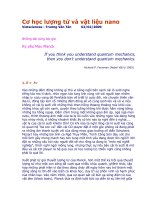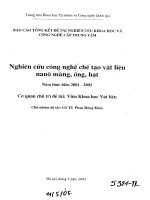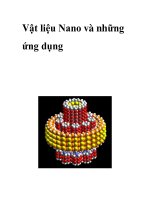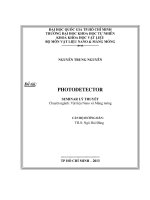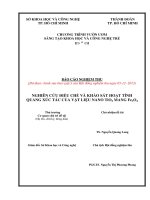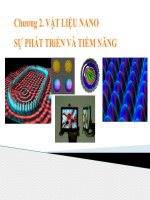Slidw vật liệu nano và màng mỏng nontraditional microfabrication techniques
Bạn đang xem bản rút gọn của tài liệu. Xem và tải ngay bản đầy đủ của tài liệu tại đây (1.44 MB, 38 trang )
.c
om
cu
u
du
o
ng
th
an
co
ng
Nontraditional Microfabrication
Techniques
CuuDuongThanCong.com
/>
th
an
co
ng
• Electric discharge
machining
• Precision mechanical
machining
• Thermomigration
• Photosensitive glass
• Focused ion beam
• SCREAM
cu
u
du
o
ng
• Template replication
• Sealed cavity formation
• Surface modification
• Printing
• Stereolithography (3-D)
• Sharp tip formation
• Chemical-mechanical
polishing
.c
om
Other Micromachining Techniques
CuuDuongThanCong.com
/>
.c
om
Sealed Cavity Formation
ng
• Form structure using sacrificial material and
cu
u
du
o
ng
th
an
co
small access holes
• Cover holes using one of three methods
– Simple application of glues, plastics, photoresist,
etc
– Thin-film application such as sputtered,
evaporated, and CVD films
– Reactive sealing, i.e. thermal oxidation, etc
• Gettering- collect gases in cavity
CuuDuongThanCong.com
/>
.c
om
Surface Modification
cu
u
du
o
ng
th
an
co
ng
• Used to change surface properties, especially in
biomedical applications
• HMDS used to “methylate” surface and remove
hydroxyl groups
• Self-assembled monolayers (SAMs) formed using
RSiCl3 (R is alkyl group)
• Often used to reduce wear and adhesion forces
• Apply dendrimers (hyper-branched polymers) for
molecule recognition
CuuDuongThanCong.com
/>
Printing
cu
u
du
o
ng
th
an
co
ng
.c
om
• Useful for non-planar substrates
• Very low-cost
• Screen printing
– Resolution limit of about 100 mm
– Alignment more difficult
– Great for patterning polymer layers in biosensors
– One step process
– Requires liquid form
• Transfer printing
– Raised bumps used to transfer ink, etc
• Powder loaded polymers
– Material properties dependent on material in plastic
liquid that can be rolled on and patterned
• Ink jet
CuuDuongThanCong.com
/>
.c
om
Micromechanical Machining An Option to Lithography
cu
u
du
o
ng
th
an
co
ng
• Can produce extremely smooth, precise, highresolution
structures
• Expensive, non-parallel, but handles much larger
substrates
• Precision cutting on lathes produces miniature
screws, etc with 12 mm accuracy
• Chip Processes
– diamond machining, tools ~100 mm thermal surfaces, fluid
microchannels
– microdrilling, tools > 25 mm manifolds, fiber optics, molds
– micromilling, tools ~22 mm, features < 8 mm molds,
masks, thermal surfaces
CuuDuongThanCong.com
/>
.c
om
Micromechanical Machining An Option to Lithography
cu
u
du
o
ng
th
an
co
ng
• Energy Processes
– microEDM, tools > 10 :m microturbines,
toolselectrodes, stators
– focused ion beam (FIB), atomic-scale
machining,
micromilling tools, probes, etc.
– laser, micron-scale spot ablate hard
materials, polymerization
CuuDuongThanCong.com
/>
.c
om
Micromechanical Machining
Characteristics
cu
u
du
o
ng
th
an
co
ng
• Relative tolerances are more typically 1/10 to 1/1000
of feature or part dimensions
• Absolute tolerances are typically similar to those for
conventional precision machining (micrometer to submicrometer)
• Feature is often inaccessible by conventional metrology
techniques (high aspect ratio boolean negative features)
• Like conventional machining, in-process, on-line metrology is
preferred over post-process or off-line metrology
CuuDuongThanCong.com
/>
.c
om
General Micromachining Metrology
cu
u
du
o
ng
th
an
co
ng
• Tool location
– Endmills 8 mm x 2 mm
– 22 mm x 3 mm
– Drills 25 mm x 4 mm
– Diamond 100 mm x 2 mm
• Part/fixture location for multiple processes in
multiple machines
• Post processing of lithographic molds
• Post processing of electroplated structures
CuuDuongThanCong.com
/>
.c
om
Complementary Processes
(Direct Removal Processes)
cu
u
du
o
ng
th
an
co
ng
• Chip making (force processes)
– Diamond machining
– Microdrilling
– Micromilling
– Grinding and polishing
– Microsawing
• Energy beam (forceless processes)
– Focused ion beam
– Micro electrical discharge
– Laser ablative and photo polymerization
CuuDuongThanCong.com
/>
.c
om
ng
cu
u
du
o
ng
th
an
co
Microfabrication Using Polymers
CuuDuongThanCong.com
/>
.c
om
Polymers for Microfabrication
cu
u
du
o
ng
th
an
co
ng
• Examples diverse
– PDMS
– PMMA
– Polyurethane
– Polyimide
– Polystyrene
• Disadvantages
– Low thermal stability
– Low thermal and electrical conductivity
– Techniques for fabrication on microscale
not as well developed
CuuDuongThanCong.com
/>
.c
om
PDMS (Polydimethylsiloxane)
cu
u
du
o
ng
th
an
co
ng
• Polydimethylsiloxane
• Advantages
– Deforms reversibly
– Can be molded with high fidelity
– Optically transparent down to ~300 nm
– Durable and chemically inert
– Non-toxic
– Inexpensive
CuuDuongThanCong.com
/>
Soft Lithography
cu
u
du
o
ng
th
an
co
ng
.c
om
• Developed by Whitesides, et. al. at Harvard
• Microcontact printing
– Elastomeric stamp
– Patterns of self-assembled monolayers (SAMs) and
proteins
– SAMs allow a variety of surface modifications
• Thickness variation by changing tail length
• Modification of tail group changes surface properties
• Variety available for different substrate materials
– Other SAM advantages
• Self healing and defect rejecting
• Ultrathin resists and seed layers
• Do not require clean room facilities
• Low cost
– Fabricated using a PDMS mold of “photoresist” structure
CuuDuongThanCong.com
/>
High Aspect Ratio Molding
an
co
ng
.c
om
LIGA Process; typical Materials are Ni, NiCo
• Micromachining; typical Materials are Brass, Al alloys
• Si Micromachining; typical Materials are Si, Ni
• Combination of Various Techniques Followed by Electroplating:
Ni, NiCo
cu
u
du
o
ng
th
Compound Abbrivation Glass Transition [ºC]
Polymethylmethacrylate PMMA 105
Polycarbonate PC 150
Polysuflone PSU 190
Polyoxymethylene POM 165
Polyethylethylketone PEEK 340
Polyvinylidenfluorid PVDF 170
Polyamide PA 12 180
CuuDuongThanCong.com
/>
.c
om
Mold Inserts
cu
u
du
o
ng
th
an
co
ng
Basic requirements
• Low mechanical stiction and friction
• No deviation from vertical sidewalls ( no
undercuts )
• Avoid surface oxidation
Chemically inert
Smooth surfaces
Defect free sidewalls
Homogeneous material properties
CuuDuongThanCong.com
/>
Common Molding Materials
an
co
ng
.c
om
POM
Poly(oxy methylene),
Tm = 156°C (Copolymer), Tproc 180°C
Tm = 175°C (Homopolymer)
Low friction, good impact strength, critical
decomposition into formaldehyde, critical
cavitation due to crystallization
mechanical applications (gear wheels)
PSU
Poly(sulfone),
Tg 190°C, Tproc 250°C
Transparent, high strength
for use at higher temperatures up to 180°C,
microfluidic pump
cu
u
du
o
ng
th
PMMA
Poly(methyl methacrylate),
Tg 100°C, Tproc 170°C-210°C
Transparent, brittle, sensitive to crack
optics, lost mold for production of metallic
microstructures
PC
Poly(carbonate),
Tg 148°C, Tproc 180°C-200°C
Transparent, good hardness and
impact strength
optics, medical
CuuDuongThanCong.com
/>
Molding of Ceramic Microstructures
cu
u
du
o
ng
th
an
co
ng
.c
om
Why are we Interested in Ceramic Microstructures ?
But
• Attractive Material Properties (Mechanical, Chemical,
Thermal,..
• Additional Functionality (PZT Effect, Conductivity,
Shrink Compensated,..)
• More Compatible to other Materials used in MST than
Polymers
• Can the Material be Processed on the Micrometer Scale ?
• Can the LIGA like Sidewall Quality be Maintained?
• Can the Microstructures be Mass Fabricated?
• Can the Overall Shrinkage due to Sintering be
Compensated and the Dimensional Accuracy Ensured?
CuuDuongThanCong.com
/>
.c
om
General Design Rules for Mold
cu
u
du
o
ng
th
an
co
ng
• Round the corners where the polymer will
shrink onto the metal
• Avoid patterning numerous aspect ratios in
one sample (ie. Use AR that deviate +/- 2
from the average AR in the pattern)
• Centralize the patterns that are most
critical.
Deviation further from center are more
difficult to emboss
CuuDuongThanCong.com
/>
.c
om
General Design Rules for Mold
cu
u
du
o
ng
th
an
co
ng
• Sidewall quality is critical
– Surface roughness > 500 nm
– Perpendicularity >85° with >2 °
center bowing
• Bottom surface quality less critical
– Surface roughness > 10 mm
CuuDuongThanCong.com
/>
LIGA process
.c
om
• LIGA
– German term
co
an
th
du
o
ng
– Also called DXRL (Deep Xray lithography)
– XRL
ng
• Lithographie,
Galvanoformung,
Abformung
Lithography,
electroplating, molding
cu
u
• IC: small feature sizes
using small wavelength of
X-ray (many industry gave
up)
• MEMS: Very thick
structures using high
energy
CuuDuongThanCong.com
Source : IMM, Institut für Mikrotechnik mainz Gmbh
/>
LIGA examples
.c
om
High aspect ratio microstructures
(HARMs)
u
du
o
ng
th
an
co
ng
– Thickness: ~2 mm
– Aspect ratio: > 10:1
cu
•
CuuDuongThanCong.com
/>
UV-LIGA process
• UV-LIGA
.c
om
Cr mask
Polymer
ng
co
th
Electroplating
of metal
u
– Polyimide
du
o
• Low aspect ratio (< 1:1)
• ~40 m thick
Polymer
mold
ng
• Polymer as electroplating mold
– PR
Seed
layer
Substrate
an
– Standard UV lithography
– UV-sensitive polymeric resists:
+ve PR, -ve PR (SU-8 epoxy,
polyimide, thick photoresist)
– Multi-layer possible
– Cost-effective compared to LIGA
(Also called LIGA-like or poor
man’s LIGA)
UV light
cu
• Low aspect ratio (< 3:1)
• ~80 m thick
Electroplated
metal
– SU-8 epoxy
• High aspect ratio (~10:1)
• ~ 500 m thick
CuuDuongThanCong.com
Positive resist
Negative resist
/>
.c
om
Examples of UV-LIGA processed SU-8
Tilted SU-8 exposure
ng
20 m
UV light
cu
u
du
o
ng
th
an
co
110 m
CuuDuongThanCong.com
31.6o
/>
Molding
• Molding
co
ng
.c
om
– Low cost massive
production of precise plastic
parts using LIGA or UV-LIGAprocessed metallic mold
inserts
th
cu
u
du
o
ng
– Molten plastic is injected
onto a metallic mold insert
– Heated above glass
transition temperature (Tg)
of the plastic
– Polymers
an
• Injection molding
ã PE, PP, PC, PMMA, COC, or
biodegradable polymers
(e.g. RESOMERđ)
CuuDuongThanCong.com
/>

